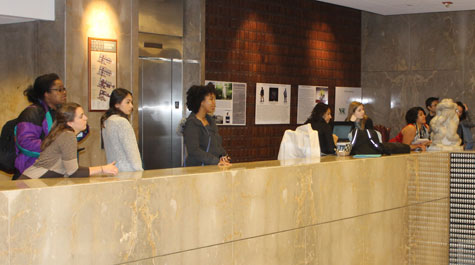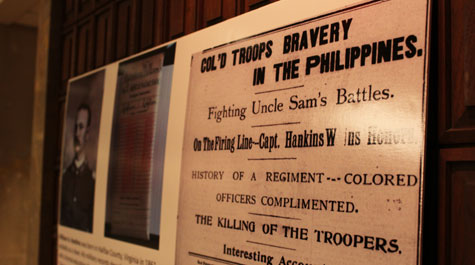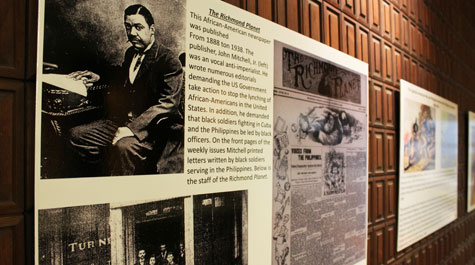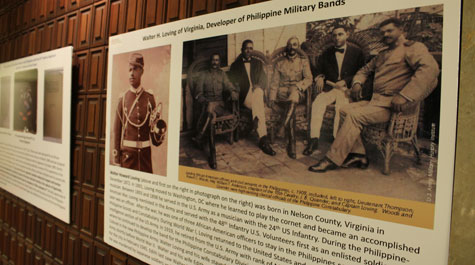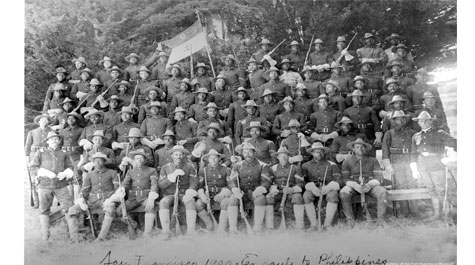‘Buffalo Soldier’ exhibit highlights role of black service members in Philippine-American War
Photos and illustrations illuminating the lives of Buffalo Soldiers during the Philippine-American War are currently on display in Swem Library’s Botetourt Gallery as part of an exhibit organized by the William & Mary Asian & Pacific Islander American Studies program.
Hidden Virginia History: The Connection between the Buffalo Soldiers and the Philippines will be on display until May 15.
The exhibit is a collaboration between the Virginia Foundation for the Humanities, Norfolk State University, the Filipino American National Historical Society – Hampton Roads Chapter and W&M to promote the actions of African-American service members — or Buffalo Soldiers — participating in combat operations in the Philippines between 1899 and 1902. Research, writing and fabrication for the exhibit was conducted by members of the Filipino American Historical Society – Hampton Roads Chapter led by Dr. April T. Manalang of Norfolk State University. The lead historian for the project was Jeffrey Acosta an adjunct instructor of U.S. History at Tidewater Community College and vice president of FANHS-HR chapter.
“We are thrilled to welcome this exhibit into the library,” said Carrie Cooper, dean of university libraries. “It is especially timely as the university is preparing to mark the 50th anniversary of African-American residential students.”
The Philippine-American War
Following its defeat in the Spanish-American War of 1898, Spain relinquished the control of its colonies located in the Philippines, Guam and Puerto Rico to the United States at the Treaty of Paris on Dec. 10, 1898. In the following year, Filipino nationalists under the leadership of Emilio Aguinaldo sought independence from their colonial rulers, according to Francis Tanglao-Aguas, professor of theatre and Asian and Pacific Islander American studies. On February 4, 1899, the U.S. government ordered the U.S. military to conduct combat operations against the Filipino soldiers. According to the U.S. Department of State, the war lasted three years and resulted in the death of over 4,200 American and over 20,000 Filipino combatants with as many as 200,000 Filipino civilians dying from violence, disease and famine.
According to official records of the Presidio of San Francisco, the military garrison charged with housing companies from black infantry units before deployment to the island nation, many black leaders and black-owned newspapers like the Indianapolis Freeman supported the inclusion of African-American soldiers in the war.
However, the records also state that many prominent African-American political activists of that time like Ida B. Wells-Bartlett condemned America’s government as hypocritical for using black soldiers as tools to enlarge its territory. “Negroes should oppose expansion until the government was able to protect the Negro at home,” Wells-Bartlett said in an account to the Cleveland Gazette in January 1899.
But according to Acosta, as the war raged on the island, the U.S. Army had to shift its military strategy to face counter-insurgency tactics conducted by Filipino soldiers. The Filipinos fighters used methods like blending in with the civilian populace and directed quick attack skirmishes against patrolling U.S. Army infantry units. Filipino revolutionaries noted the black soldiers’ ability to adapt to the new mission parameters, and therefore the Filipinos had a different opinion of their American adversaries with darker skin, said Acosta.
“Filipinos had a mixed view towards African American soldiers based on researched history provided by the accounts of Filipino soldiers and civilians,” he said. “African Americans did not share the racial prejudice of their white counterparts towards Filipinos in that war. But, Filipino soldiers did notice that the black soldiers fighting were at times relentless in their pursuit of Emilio Aguinaldo’s army of the 1st Philippine Republic.”
Turning point
Although African-Americans have served in the U.S. military since the Revolutionary War in some form, Acosta noted that the Philippine-American War was quite possibly the critical turning point for future military service of African-Americans.
The U.S. Army began to commission black officers from the ranks of the enlisted who had distinguished records. Acosta said that the level of success and aggressiveness of African-American soldiers in the Philippines was dependent on the quality of their leaders. Of those leaders to be commissioned, one later became the U.S. military’s first African-American general officer, said Acosta.
“Benjamin O. Davis Sr. was one of these men,” he said. “Davis Sr. was the first African-American promoted to the rank of major general in the history of the United States Army. His son, Benjamin O. Davis, Jr. went on to become an officer in the U.S. Army Air Corps and helped to establish the Tuskegee Airmen who flew and fought with distinction during World War II. Davis Jr. retired at the rank of lieutenant general in the U.S. Air Force in 1965, but was advanced to full general by former President Bill Clinton in 1998.”
However, if it had not been for influential black journalists and African-American newspapers such as The Richmond Planet, the world may have never known more about the Buffalo Soldiers’ sacrifices and contributions to U.S. and Filipino history, according to Acosta.
“The hardest part of our research was identifying African-American soldiers from Virginia who fought in this war,” he said. “But if it had not been for John Mitchell, Jr., the publisher of the Planet who published letters written to his newspaper by black soldiers serving in the U.S. Army during the Spanish-American and Philippine-American Wars, we may have never known what truly went on. The hunt for and locating of primary and secondary source materials concerning Americans and Filipinos who participated in the Philippine-American War was the most rewarding aspect of this project.”
Acosta stated that all soldiers of the six all-black regiments serving in the Philippines came from every state in the union, but he pointed out that Captain William A. Hankins, Private Rienzi Lemus, and chief musician Walter H. Loving came from Virginia and helped set the bar for future black soldiers to achieve.
“Lemus became a prominent African American labor leader as the president of the Brotherhood of Dining-Car Employees and co-leader of Dining Car Cooks and Waiters Association after he left the army,” he said. “Hankins went on to become the co-founder of the all-African American Mechanics Savings Bank of Richmond, Virginia in 1901. And Loving helped organized the Philippine Constabulary Band that went on to tour the world.”
Tanglao-Aguas believes that the exhibit will help bring light to the experience of African-Americans during the war, which is often overlooked in the American narrative.
“Seeing that Buffalo Soldiers were used in helping to grow the very same nation that did not even treat them with equal protection under the law is worth examining, particularly at this current moment when we see the leveraging or weighing of American citizenship based on religion, race or nationality,” “This analysis is at the forefront of what we explore with our students in Asian & Pacific Islander American studies, as well as Africana studies.”















